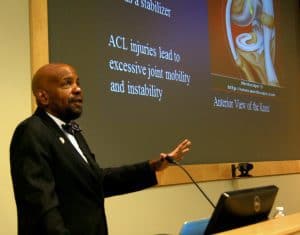Communication Skills Honed at Student Research Day
| April 14, 2017 | In the classroom, lab and clinic, UAMS students learn to “walk the walk,” and with the annual Student Research Day held April 12, they also learn to “talk the talk.”
Robert E. McGehee Jr., Ph.D., dean of the UAMS Graduate School, said such events give students the all-important experience of communicating about their work.
“Because, at the end of the day, we’re all salesmen,” McGehee said. “If you can’t sell yourself, and can’t relate what you are doing to a diverse audience, you’re really missing out on one of the big things we want you to learn at UAMS no matter what discipline you’re in.”
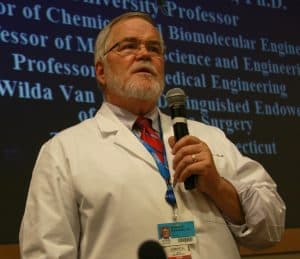
Robert E. McGehee Jr., Ph.D., dean of the UAMS Graduate School, welcomes the audience to the Distinguished Lectureship in Biomedical Research, which is named in his honor.
The annual event includes morning and afternoon poster sessions and has been paired since 2011 – thanks to an endowment from an anonymous couple – with the Distinguished Lectureship in Biomedical Research, which is named in McGehee’s honor.
New to this year’s Research Day were the UAMS Three Minute Thesis (3MT) Finals. Billed as similar to an “elevator pitch,” participants were asked to summarize their research in an engaging way in three minutes or less. Ten students across five colleges and the graduate school competed in the finals.
Activities were held in the I. Dodd Wilson Education Building, which was literally abuzz during the poster sessions with the sound of students from each college and the graduate school explaining their research to the judges. In all, about 70 volunteer judges helped make the event possible. With 132 poster presenters and more than 80 total 3MT participants, McGehee said that student engagement this year was the best ever.
In addition, there was significant excitement over the speaker, Cato T. Laurencin, M.D., Ph.D. who spoke to an audience of over 300. Students lined up to have their photos taken and exchange a few words with Laurencin, the Albert and Wilda Van Dusen Distinguished Professor of Orthopaedic Surgery at the University of Connecticut, who has won numerous distinctions, including national-level awards from two presidents. His innovations are frequently listed among the top scientific achievements of the century.
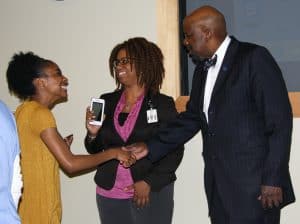
Graduate students Andrea Edwards, left, and Tiffany Miles meet guest lecturer Cato T. Laurencin, M.D., Ph.D., who spoke about his groundbreaking work in regenerative engineering.
Laurencin gave an overview in his groundbreaking work in regenerative engineering. He and his research partners have successfully developed processes and technologies for re-growing bone and skin, nerves, ligaments and other tissues. His process for regenerating a torn ACL has been used in humans for three years. His current project to repair rotator cuff tears and other shoulder injuries through regeneration has proven successful in mice.
Looking forward, he has set a goal to regenerate a knee within the next seven years and an entire limb in 15 years. Laurencin characterized it as a lofty – but achievable – goal.
“Actually, a lot of people have told me, ‘believe me, it is a moonshot,’ but as I’ve said before, the last time I’ve checked, we’ve been to the moon,” Laurencin said.
Jet Patterson, a second-year medical student, won the 3MT Finals with her project, “Stress and Empathy in Gross Anatomy: Dissection and Depersonalization.”
She is developing educational interventions to help medical students better process their emotions when they dissect their first cadaver as part of the human structure course. Patterson and her research partners’ goal is to prevent students from turning to unhealthy coping mechanisms that dehumanize the cadaver and may later cause similar patterns during patient interactions.
“This is a great platform to get the word out about the research we’re doing, and it was also a great opportunity for me to think through how I communicate about this. Especially with audiences who maybe don’t know much about medical school, how do I make them understand the significance of this and the long-term impact it can have?” Patterson said. “I think half the battle is communication, and I feel like I learned a lot from this process.”
After two years of research, Patterson and her group are now brainstorming interventions that will – along with help from faculty – be implemented with next year’s human structure students.
Award winners included:
Three Minute Thesis
Overall winner: Jet Patterson – “Stress and Empathy in Gross Anatomy: Dissection and Depersonalization”
Runner up: Daniel Meeker – “Designing Nanoparticles for the Treatment of Surgical Infections”
People’s choice: Hannah Rabon – “Incidence and Prevention of QTc Interval Prolongation When Using Combinations of QTc-Prolonging Antimicrobials and Antipsychotics”
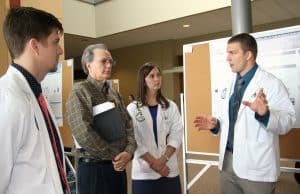
Student Wesley Wenzel, right, gives a poster talk to Paul Prather, Ph.D., of the Department of Pharmacology and Toxicology in the College of Medicine, while fellow students Kenny Spencer, left, and Rachele Struthers look on.
Posters:
Graduate School:
First: Megan Reed – “Tryptophan 2,3-dioxygenase Inhibitor 680C91 Decreases Glioblastoma Multiforme Genomic Instability and Sensitizes Cells to Chemotherapeutic Treatment”
Second: Magdalena Delgado – “G I Phase Arrest Induced by CDK 4/6 Inhibition Prevents Vincristine Cytotoxicity in Primary Acute Lymphoblastic Leukemia Cells”
Professional Student:
First: Tabitha Jaggers – “The Effectiveness of Intravenous Ketamine Infusions in Treating Comorbid Major Depression Disorder and Post-traumatic Stress Disorder”
Second: Savannah Fletcher – “Size Matters: A Correlation of TIPS Outcome and the Size of the Liver”
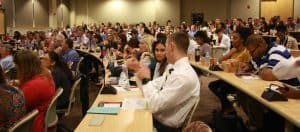
More than 300 audience members gather to hear Cato T. Laurencin, M.D., Ph.D., speak as part of the Robert E. McGehee Jr., Ph.D., Distinguished Lectureship in Biomedical Research.
Postdoctoral:
- First: Sun Hee Moon – “Novel Linear Lipopeptide Paenipeptin C’ Targeting Antibiotic-resistant Pathogens”
Housestaff:
First: Ashley Stoner – “Impact and Seasonality of Respiratory Viral Illnesses: A Retrospective Study”
Second: Jamie Waldron – “IL-33 and IL-13 Receptors are Up-regulated in Precision Cut Lung Slices from Donors with Asthma During RV39 Infection”

